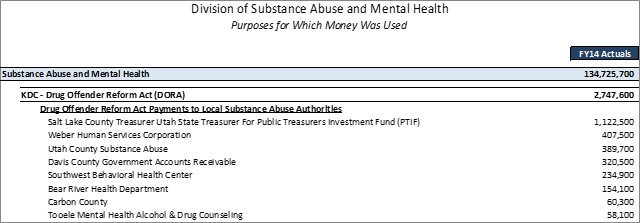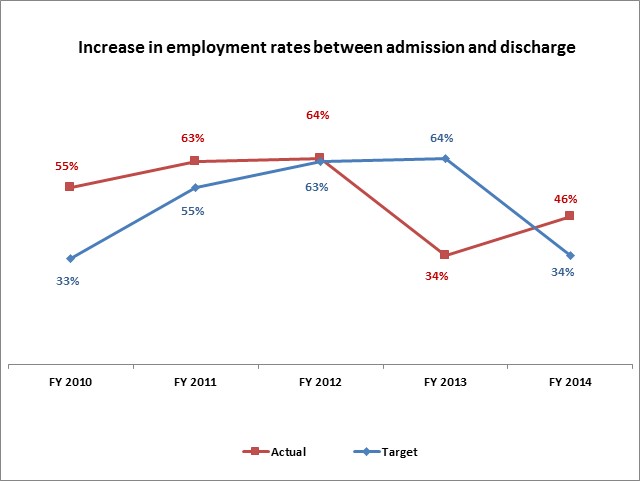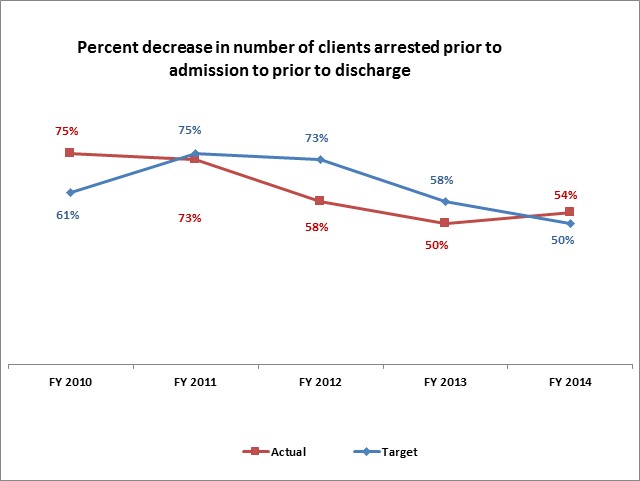DORA was designed to expand offender access to treatment, provide for smarter sentencing by judges, and provide increased community supervision. This legislation was predicated on a three-year DORA pilot program, created in 2005, which operated in the Third Judicial District Court in Salt Lake County as well as a statewide initiative enacted in 2007 via Senate Bill 50 of the same title. Senate Bill 202, Drug Offender Reform Act (DORA), was passed during the 2009 General Session of the Legislature reducing the scope of DORA from a statewide initiative for both probationers and parolees to serving probationers only in six local substance abuse authority areas.
During the 2015 General Session, the Legislature appropriated for Fiscal Year 2016, $2,747,100 from all sources for Drug Offender Reform Act (DORA). This is a 0 percent change from Fiscal Year 2015 revised estimated amounts from all sources. The total includes $2,747,100 from the General/Education Funds, a change of 0 percent from revised Fiscal Year 2015 estimates.
For the most recent completed fiscal year, the following information represents the purposes for which the money was used:



Regarding the negative trend greater than 5% in the increase in employment rates from the DORA program performance measures, the agency states, "It is likely that the cause for the 'decrease in increase in employment' from 2011 to 2014 is due to the unemployment rates over that period. There were far fewer individuals employed at admission in 2011 than there were in 2014. Since the increase is a percentage of the change, not simply a percentage increase, the fewer numbers employed due to the recession in 2011 compared to improved employment opportunities in 2014 would make it easier to show larger improvement. (For example, if 40 individuals were employed in 2011 of every hundred at admission, and 70 were employed at discharge, the percentage increase would be 75%. If in 2014, there were 50 people employed at admission and 70 at discharge, the percentage change would be 40%.) It is important to remember that both numbers show a positive increase in the numbers of individuals employed. DSAMH will continue to put emphasis on ensuring clients have adequate housing and employment, as those are key factors in reducing recidivism and sustaining recovery."
Regarding the negative trend greater than 5% in the percent decrease in the number of clients arrested from the DORA program performance measures, the agency states, "It is likely that the 'decrease in the decrease of clients arrested' is also due to the manner that the rate is calculated and the decrease in crime during the period in question. The fewer individuals committing crimes in the 30 days prior to admission means a smaller percentage. (Example: 40 individuals out of every hundred at admission in 2011 versus 20 individuals at discharge - 50% decrease. 30 individuals out of every hundred at admission versus 20 individuals at discharge - 33% decrease.) DORA has been proven to reduce the numbers of individuals who commit criminal acts and the close collaboration between treatment and corrections staff will continue to be emphasized to continue to reduce the overall rate of recidivism."
Statute requires the Utah Substance Abuse and Anti-Violence Coordinating Council (USAAV) to provide ongoing oversight for implementation and program functioning, evaluation of impacts and results, development of an implementation plan, and approval of plans submitted by local substance abuse authorities for DORA. The Department of Human Services then allocates funds for approved plans and monitors contracts according to approved plans and contractual requirements.
The Legislature appropriated approximately $3.6 million ongoing funding for Fiscal Year 2014 for DORA treatment and supervision. Of that amount, $2,765,900 was allocated to the Department of Human Services for the purposes of assessing and treating drug offenders in the substance abuse authority areas identified by USAAV which include Cache, Weber, Davis, Salt Lake, Utah, and Washington/Iron counties.
COBI contains unaudited data as presented to the Legislature by state agencies at the time of publication. For audited financial data see the State of Utah's Comprehensive Annual Financial Reports.